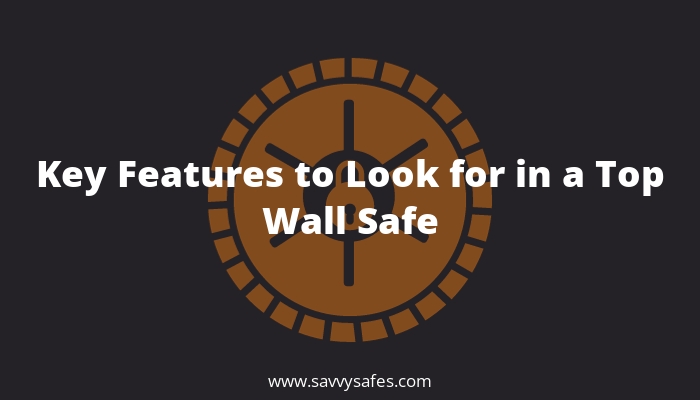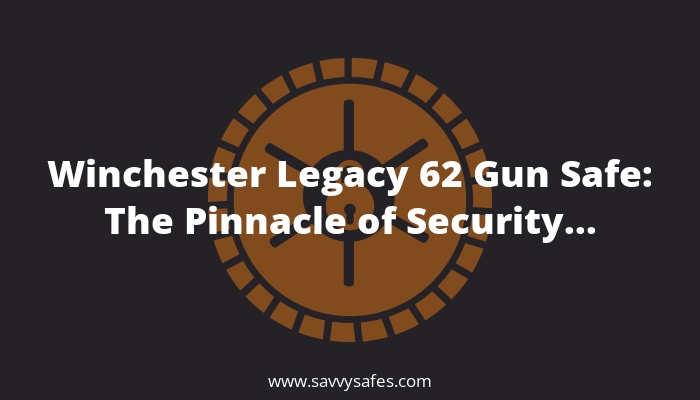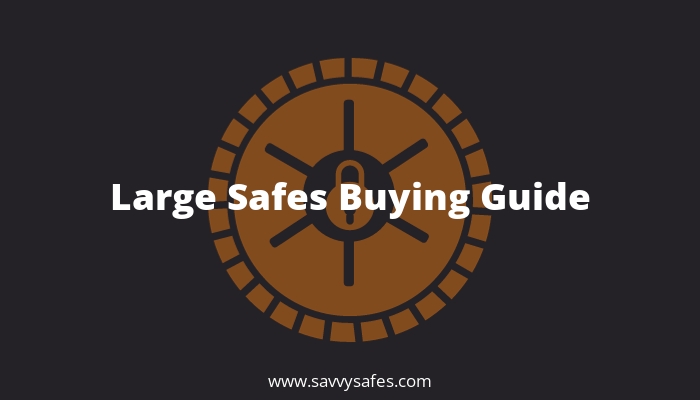In my years of experience in the security industry, I’ve come to realize the paramount importance of safeguarding one’s valuables.
A wall safe isn’t just a metal box; it’s a sanctuary for your cherished possessions, vital documents, and hard-earned savings.
When you’re in the market for a top wall safe, it’s essential to know what to look for. Let’s walk through the key features that define a top-tier wall safe.
“Security is not a product, but a process.” – Bruce Schneier
CONTENTS:
Material Durability: The Backbone of Security
When I first ventured into the realm of security, one of the earliest lessons I learned was the significance of material durability. The very essence of a wall safe lies in its ability to resist external threats, and this resistance is primarily determined by its construction material.
Steel Quality: The Gold Standard
Steel has long been the preferred choice for safes, and for good reason. Its inherent strength and durability make it nearly impervious to common break-in tools like drills and crowbars. Over the years, I’ve come across various grades and gauges of steel:
- Gauge Matters: The thickness of steel is measured in gauges. Contrary to what one might assume, a lower gauge indicates thicker steel. For instance, a 10-gauge steel wall is thicker and more robust than a 14-gauge one. When selecting a wall safe, I always recommend opting for the thickest gauge within your budget.
- Solid Steel vs. Composite: Some safes are made of solid steel, while others use a composite construction, combining steel with other materials for added fire resistance. While both have their merits, solid steel safes tend to offer better burglary protection.
Key Takeaway: Always inquire about the gauge and type of steel used in the safe. This information often provides a clear insight into the safe’s overall durability.
Fire and Water Resistance: Battling the Elements
Natural disasters are unpredictable. Fires can ravage homes, and floods can cause irreparable damage. In my experience, the aftermath of such events often brings forth heartbreaking stories of lost heirlooms, invaluable documents, and cherished memories. This is where fire and water resistance come into play:
- Fireproof Ratings: A top wall safe should offer protection against fires. These safes undergo rigorous testing to determine how long they can protect their contents at specific temperatures. Common ratings include 30 minutes, 1 hour, or 2 hours at temperatures up to 1700°F. When I advise clients, I emphasize the importance of understanding these ratings and choosing a safe that aligns with their specific needs.
- Waterproof Seals: Water damage can be just as devastating as fire. Top wall safes often feature waterproof seals that prevent water ingress, protecting the contents from potential water damage. Whether it’s due to floods, plumbing issues, or sprinkler systems, a waterproof safe offers an added layer of protection.
Key Takeaway: A truly top-tier wall safe is one that stands resilient against both fire and water. It’s an investment in comprehensive protection.
Locking Mechanism: The Heartbeat of a Safe
Throughout my journey in the world of security, I’ve often been reminded of the adage, “A safe is only as good as its lock.” The locking mechanism is, without a doubt, the most critical component of a wall safe. It’s the gatekeeper, the primary barrier between potential intruders and your valuables.
Combination Locks: The Timeless Classic
There’s something inherently reassuring about the tactile feel of a combination dial. These locks have graced safes for over a century and continue to be a favorite among many:
- Mechanical Reliability: One of the reasons I’ve always admired combination locks is their mechanical nature. They don’t rely on batteries or electronics, which means fewer components that can fail. The sheer simplicity of their design ensures longevity and reliability.
- Security Considerations: While combination locks are secure, it’s crucial to regularly change the combination and ensure it’s not easily guessable. Over the years, I’ve advised countless individuals to avoid using easily decipherable combinations like birthdays or anniversaries.
Key Takeaway: If you’re a fan of traditionalism and appreciate mechanical reliability, combination locks are a stellar choice.
Electronic Keypads: The Modern Marvel
The digital revolution has left no stone unturned, and wall safes are no exception. Electronic keypads represent the perfect blend of modernity and security:
- Convenience at Your Fingertips: One of the standout features of electronic keypads is the ease of operation. With just a few button presses, access is granted. Additionally, changing the passcode is a breeze, allowing for enhanced security.
- Backup Measures: A common concern I’ve encountered regarding electronic locks is the fear of battery failure. However, top wall safes often come equipped with backup keys or external power sources to address this very concern.
Key Takeaway: If you’re looking for a blend of modern convenience and robust security, electronic keypads are the way to go.
Biometric Access: The Future is Now
Biometric technology has taken the world by storm, and wall safes have embraced it wholeheartedly. The promise of security based on unique biological traits is truly revolutionary:
- Rapid Access: In emergency situations, every second counts. Biometric safes offer almost instantaneous access, often unlocking within seconds of recognizing a fingerprint.
- Unique Identification: What sets biometric access apart is its reliance on unique physical characteristics. Fingerprints, retina scans, and facial recognition ensure that only authorized individuals can access the safe.
Key Takeaway: For those who seek the pinnacle of security technology, biometric access is the answer. It’s a testament to how far we’ve come in the realm of security.
Size and Capacity: Tailoring to Your Needs
Throughout my years in the security sector, I’ve come to understand that one size does not fit all, especially when it comes to wall safes. The diversity in individual needs is vast, and the market has responded with a plethora of size options. Here’s my deep dive into understanding the significance of size and capacity in wall safes.
Understanding Your Needs: The First Step
Before even beginning the search for a wall safe, it’s imperative to assess what you intend to store. Over the years, I’ve seen individuals regret purchasing a safe that’s either too small or excessively large for their needs. Here’s a simple exercise I often recommend:
- List Down Items: Take a moment to jot down all the items you plan to store in the safe. This could range from jewelry, cash, and passports to larger items like documents, electronics, or even firearms.
- Anticipate Future Additions: Life is dynamic, and our possessions change over time. Maybe you’ll acquire more jewelry, add to your document collection, or have other valuables in the future. Always account for potential additions.
Key Takeaway: A clear understanding of your current and future storage needs is the foundation for choosing the right wall safe size.
Deciphering Size Options
Wall safes come in a myriad of sizes, each tailored for specific storage needs:
- Compact Safes: Ideal for individuals with limited storage needs. These safes are perfect for storing small valuables like rings, watches, and cash. Their compact nature also allows for more discreet installation options.
- Medium Safes: A balance between size and capacity. Medium safes can comfortably store documents, electronics, and a moderate collection of valuables. They’re the go-to choice for many homeowners.
- Large Safes: For those with extensive storage needs. Large wall safes can accommodate multiple shelves, providing organized storage for a wide array of items.Key Takeaway: Choose a size that aligns with your storage needs while also allowing some wiggle room for future additions.
Depth Matters
While height and width are often the primary focus, I’ve always emphasized the importance of depth in wall safes. A safe that’s too shallow might not accommodate larger items, while one that’s too deep could pose installation challenges.
- Standard Wall Depth: Most interior walls have a standard depth of about 4 inches. However, exterior walls or special constructions might offer more depth. It’s crucial to measure the depth of your intended installation location.
- Protruding vs. Flush Installation: Some individuals prefer safes that sit flush with the wall, offering a seamless look. Others might not mind a safe that protrudes slightly, especially if it’s inside a closet or a hidden location.Key Takeaway: Depth is a critical dimension that often gets overlooked. Ensure your chosen wall safe aligns with the depth of your installation location.
Installation and Concealment
One of the most intriguing aspects of wall safes, in my opinion, is their ability to blend seamlessly into their surroundings. Over the years, I’ve marveled at the ingenuity of installations, with safes concealed behind artwork, tucked away in closets, or even hidden in plain sight. Let’s delve into the art and science of wall safe installation and concealment.
Choosing the Right Location
The location of a wall safe is paramount, not just for security but also for ease of access. Here are some insights I’ve gathered over the years:
- Avoiding Obvious Spots: While the master bedroom might seem like an obvious choice, it’s also the first place burglars tend to check. I often recommend thinking outside the box—perhaps a hallway, home office, or even a child’s room.
- Accessibility Matters: While concealment is crucial, it shouldn’t come at the cost of accessibility. The safe should be easily reachable, especially if you intend to access its contents frequently.
Key Takeaway: Balance concealment with accessibility. Think like a burglar, but also consider your daily routines.
The Installation Process
Installing a wall safe might seem daunting, but with the right tools and a bit of patience, it’s a manageable task. Here’s a brief overview:
- Stud Location: Walls typically have vertical studs spaced either 16 or 24 inches apart. Using a stud finder, identify the location of these studs as they’ll play a pivotal role in supporting the safe.
- Cutting the Opening: Once you’ve marked the desired location, it’s time to cut an opening in the wall. This requires precision, ensuring the hole aligns perfectly with the safe’s dimensions.
- Securing the Safe: With the opening ready, slide the safe in and secure it using the provided bolts or screws. It’s essential to anchor the safe to the studs for maximum security.
Key Takeaway: While DIY installation is feasible, don’t hesitate to seek professional help if you’re unsure. A correctly installed safe offers optimal security.
Mastering the Art of Concealment
Concealment elevates the security of a wall safe. Over the years, I’ve encountered some truly ingenious concealment methods:
- Behind Artwork or Mirrors: A classic method. Large paintings or mirrors can easily hide a wall safe, ensuring it remains out of sight.
- Furniture Camouflage: Placing a piece of furniture, like a bookshelf or cabinet, in front of the safe is an effective concealment strategy.
- Decorative Panels: Some homeowners opt for decorative wall panels or sliding panels that can discreetly hide the safe.
Key Takeaway: The best concealment is one that doesn’t arouse suspicion. Think of methods that blend naturally with your home’s decor.
Modern Innovations: Embracing Technology
As we progress further into the digital age, it’s evident that technology is reshaping every facet of our lives. Wall safes are no exception. Over the years, I’ve witnessed a remarkable evolution in safe technology, with modern innovations enhancing both security and convenience. Let’s explore these advancements.
Smart Connectivity: The Digital Frontier
The rise of smart homes has paved the way for interconnected devices, and wall safes have joined this digital revolution:
- Remote Monitoring: One of the standout features I’ve come across is the ability to monitor your safe remotely. Through dedicated apps, you can receive real-time alerts, track access logs, and even control certain settings from anywhere in the world.
- Integration with Home Security Systems: Some modern wall safes can seamlessly integrate with home security systems. This means that any unauthorized access attempt can trigger alarms, notify security agencies, or even initiate lockdown protocols.
Key Takeaway: Embracing smart connectivity not only enhances security but also offers unparalleled peace of mind.
Backup Power Solutions: Always On Guard
A common concern I’ve often heard is the fear of electronic safes becoming inaccessible during power outages. Modern safes, however, have addressed this concern head-on:
- External Power Ports: Many electronic safes come equipped with external power ports. In the event of battery failure, you can simply connect an external power source to access the safe.
- Dual Access Mechanisms: Some safes offer a blend of electronic and mechanical access. So, even if the electronic component fails, you can still access the safe using a traditional key or combination dial.
Key Takeaway: Modern safes are designed with redundancy in mind, ensuring you’re never locked out.
Environmental Sensors: Beyond Traditional Security
While the primary purpose of a wall safe is to guard against theft, modern safes have expanded their protective capabilities:
- Humidity and Temperature Sensors: I’ve seen safes equipped with sensors that monitor internal conditions. These sensors alert you if humidity or temperature levels exceed safe thresholds, potentially protecting sensitive items from damage.
- Air-Tight Seals: Some top-tier safes come with air-tight seals, creating a controlled environment inside. This is particularly beneficial for storing sensitive documents, electronics, or antiques.
Key Takeaway: Modern innovations extend protection beyond theft, ensuring the safe’s internal environment is optimal for your valuables.
Brand Reliability: Trust is Earned
In my extensive journey through the world of security, I’ve come to understand that while features and specifications are crucial, the brand behind a product holds immense significance. A brand’s reputation is built over years, even decades, of consistent performance, customer satisfaction, and innovation. Let’s explore the importance of brand reliability in the realm of wall safes.
The Legacy of Established Brands
There’s a certain comfort in opting for brands that have stood the test of time. These brands have weathered challenges, adapted to changing landscapes, and consistently delivered top-notch products:
- SentrySafe: A name that’s almost synonymous with safes. In my experience, SentrySafe has consistently delivered on its promise of robust construction and innovative features.
- Fort Knox: The very name evokes a sense of impenetrable security. Over the years, I’ve recommended Fort Knox safes to countless clients, and the feedback has always been overwhelmingly positive.
- Barska: In the realm of biometric safes, Barska stands out. Their cutting-edge fingerprint recognition technology is both reliable and rapid.
Key Takeaway: Established brands bring with them a legacy of trust and reliability. Their products are often the culmination of years of research, development, and customer feedback.
Emerging Brands: The New Wave of Innovation
While established brands have their merits, I’ve always kept an eye on emerging brands. These newcomers often bring fresh perspectives, innovative solutions, and a zeal to make a mark:
- Stealth: As the name suggests, Stealth focuses on discreet security solutions. Their wall safes are sleek, modern, and packed with features.
- Viking Security Safe: A brand that has quickly risen in popularity, Viking combines modern aesthetics with robust security features.
Key Takeaway: Don’t shy away from exploring emerging brands. They often bring to the table innovative solutions and competitive pricing.
Customer Reviews: The Voice of Experience
In this digital age, one of the most valuable resources I’ve found is customer reviews. These firsthand accounts offer insights that are often not covered in product descriptions or specifications:
- Performance Over Time: While a wall safe might perform impeccably initially, how does it fare over months or years? Customer reviews often shed light on a product’s long-term performance.
- Customer Support: Even the best products might require support or servicing. Reviews often highlight the quality of a brand’s customer service, which I believe is a crucial aspect of the overall product experience.
Key Takeaway: Always take the time to go through customer reviews. They offer a wealth of information that can guide your purchase decision.
Price vs. Value: Making an Informed Decision
One of the most common dilemmas I’ve encountered during my tenure in the security industry is the balance between price and value. It’s a delicate equilibrium, and understanding it is pivotal to making an informed purchase. Let’s dive deep into this often-misunderstood aspect of choosing a top wall safe.
The Allure of Bargains
In a world driven by discounts and deals, it’s easy to be swayed by attractive price tags. However, when it comes to wall safes, I’ve always advocated for a more discerning approach:
- Initial Cost vs. Long-Term Value: A cheaper wall safe might seem like a great deal initially, but how does it fare in the long run? Compromises in material quality, locking mechanisms, or features might lead to vulnerabilities or frequent maintenance needs.
- The Risk Factor: When assessing the price, always consider the value of the items you intend to store. Skimping on a few dollars might not be worth the risk of losing invaluable possessions.
Key Takeaway: A bargain isn’t always the best value. Assess the product holistically, considering its features, brand reputation, and customer reviews.
Investing in Premium Quality
On the other end of the spectrum, we have premium wall safes. These safes often come with a higher price tag, but in my experience, they justify the investment:
- Top-Tier Materials: Premium safes are often constructed using the best materials available. Whether it’s thicker steel gauges, advanced locking mechanisms, or additional features, you’re getting the best the industry has to offer.
- Brand Assurance: Established brands often back their premium products with extended warranties, excellent customer support, and a promise of reliability.
Key Takeaway: Investing in a premium wall safe is akin to investing in peace of mind. The assurance of top-tier security and brand support often justifies the higher price.
Middle Ground: The Best of Both Worlds
For those who seek a balance between cost and value, there’s a vast middle ground:
- Mid-Range Safes: These safes offer a blend of quality and affordability. While they might not have the premium features of high-end safes, they often cover all the essentials impeccably.
- Research is Key: The mid-range market is vast and diverse. I’ve always recommended thorough research, comparison, and assessment before settling on a product.
Key Takeaway: With diligent research, it’s entirely possible to find a wall safe that offers excellent value without breaking the bank.
Additional Features: The Icing on the Cake
While the core features of a wall safe are undeniably crucial, I’ve always been intrigued by the additional features that brands introduce to enhance user experience and security. These features, though sometimes overlooked, can significantly elevate the functionality and convenience of a wall safe.
Interior Lighting: Illuminating Your Valuables
There’s nothing more frustrating than fumbling in the dark, trying to retrieve an item from your safe. This is where interior lighting comes into play:
- LED Lighting: Many modern wall safes come equipped with built-in LED lights. These lights activate upon opening the safe, ensuring you have a clear view of its contents.
- Adjustable Brightness: Some premium safes offer adjustable brightness levels, allowing you to customize the lighting to your preference.
Key Takeaway: Interior lighting, though seemingly simple, can significantly enhance the user experience, especially in dimly lit environments.
Adjustable Shelving: Tailoring to Your Needs
The diversity of items people store in wall safes necessitates flexibility in storage options:
- Modular Shelves: Some wall safes come with modular shelving systems. These shelves can be adjusted, added, or removed based on your storage needs.
- Dedicated Compartments: For those who like organized storage, certain safes offer dedicated compartments for jewelry, documents, or specific valuables.
Key Takeaway: Adjustable shelving provides the flexibility to tailor the safe’s interior to your evolving storage needs.
Tamper Alerts: Enhanced Security
In the realm of modern innovations, tamper alerts stand out as a significant advancement:
- Vibration Sensors: Some advanced wall safes are equipped with sensors that detect vibrations or forced entry attempts. Any such attempt triggers an alarm, deterring potential intruders.
- Access Logs: For those who value accountability, certain electronic safes maintain access logs. These logs track every access attempt, successful or not, providing a detailed record.
Key Takeaway: Additional security features like tamper alerts and access logs offer an added layer of protection and peace of mind.
Conclusion: The Quest for the Perfect Wall Safe
In my extensive journey through the world of security, I’ve come to realize that the quest for the perfect wall safe is deeply personal. It’s a blend of understanding one’s unique needs, balancing them with available options, and making an informed decision. From material durability and locking mechanisms to brand reliability and additional features, every facet plays a pivotal role in shaping this decision.
Key Takeaways:
- Material Matters: The strength and durability of a wall safe are foundational. Always prioritize high-quality construction materials.
- Locking Mechanism: Whether you’re a fan of traditional combination locks, modern electronic keypads, or cutting-edge biometrics, choose a mechanism that aligns with your comfort and security needs.
- Size and Capacity: Tailor your choice based on what you intend to store, both now and in the foreseeable future.
- Brand Reliability: Trust is earned over time. Opt for brands that have a proven track record of excellence and customer satisfaction.
- Price vs. Value: While bargains are tempting, always assess the long-term value a wall safe offers. Sometimes, investing a bit more upfront can save a lot of heartache down the line.
- Embrace Modern Innovations: From smart connectivity to tamper alerts, modern features can significantly elevate the functionality and security of a wall safe.
In the end, a wall safe is more than just a storage solution; it’s a testament to the value we place on our possessions, memories, and the security of our loved ones. As you embark on this quest, I hope this guide serves as a beacon, illuminating the path to the perfect wall safe for your needs.
FAQs:
- How often should I change the combination of my wall safe?
- It’s advisable to change the combination periodically, especially if you suspect it might have been compromised.
- Can I install a wall safe by myself?
- While DIY installation is feasible, if you’re unsure, it’s always best to seek professional assistance to ensure optimal security.
- Are digital wall safes susceptible to hacking?
- Modern digital safes come with advanced encryption and security measures, making them highly resistant to hacking attempts.
Thank you for joining me on this comprehensive exploration of wall safes. Here’s to making informed decisions and ensuring the utmost security for your valuables!









